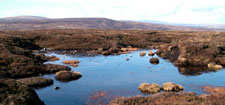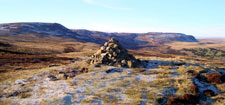Moors and Heath
Moorlands are important components of the Durham landscape, covering extensive areas on the higher ridges and plateaux of the North Pennines. Many are of national or international importance for their biodiversity. Smaller heathlands in the lowlands and Pennine fringes are survivors from the more pastoral medieval landscape and are the last refuges for heathland plants and animals in otherwise intensively managed farmlands. Many moors and heaths in the county are registered as common land, and most are now also designated as Access Land.
Issues and Objectives
Moorland Drainage
Moorland drainage or ‘gripping’ has been extensive in the North Pennines, causing damage to blanket bog, erosion of peat, and in some cases conversion of bog to acid grassland or heath. Gripping reduces the water retention capacity of the peat leading to increased flooding downstream. It also leads to drying and decomposition in the peat, resulting in the emission of carbon dioxide, a greenhouse gas. The associated erosion leads to discolouration of water in public water supplies which can be expensive to treat.
The blocking of grips can restore natural hydrological conditions to blanket bogs, increasing their ability to store water and carbon and improving water quality. The North Pennines AONB Partnership’s Peatscapes Project – funded by the Environment Agency through the Northumbria Regional Flood Defence Committee – is currently promoting grip-blocking across the area.
Objectives
- To support and encourage the restoration of natural hydrological conditions in the County’s peatlands.
Grazing Levels
Overgrazing has lead to a decline in biodiversity on some moors and a notable shift from heather to ‘white moor’ of acid grassland. Overgrazing can be a particular problem on common land due to over-registration of grazing rights and lack of co-ordinated management. It tends to be less prevalent on grouse moors where heather is conserved.
Stocking densities on the moor have increased gradually over many decades as a result of agricultural improvements such as drainage, liming, reseeding and supplementary feeding. This was given added impetus in the past by headage-based support payments for sheep and cattle. A general trend towards specialisation has also seen a decline in mixed livestock farming and an increasing emphasis on sheep. This has been linked to other vegetation changes such as the spread of bracken on some moors.
While agricultural subsidies have moved away from headage payments, the impacts of these changes on stocking levels and the intensity of management of upland moors is difficult to predict. It seems likely that these changes, coupled with resources in Higher Level Stewardship being targeted at important sites, will see stocking levels decrease and management improve on some moors. It is also possible that high stocking levels might be maintained elsewhere under economic pressures, or that stocking levels will reduce dramatically in places leading to changes in vegetation.
Objectives
- To promote environmentally sustainable moorland management.
- To encourage and support initiatives for the restoration of damaged moorland habitats.
- To monitor the effect of changing agricultural support mechanisms on moorland management to inform the development of policy.
Management of Grouse Moors
The economic importance of shooting has helped protect some moors from overgrazing or forestation in the past and many now support important bird populations that benefit in varying degrees from management for grouse. Rotational burning is an important management tool but where it is very frequent or poorly controlled it can be damaging, and particularly to sensitive habitats like blanket bog. The Heather and Grass Burning Code 2007 gives guidance on good practice. Moorland drainage or ‘gripping’- though not now as popular with grouse moor managers – also causes damage to blanket bog. Some managers are now reversing this process to improve feeding opportunities for grouse chicks. Greater diversity in moorland vegetation which incorporates stands of mature heather and native woodland or scrub along with areas of short heather, bare ground and bog or mire is likely to support a wider range of wildlife while enhancing the scenic qualities of the moorland landscape.
Objectives
- To promote sustainable management of grouse moors to meet wider environmental goals.
- To encourage observance of the Heather and Grass Burning Code 2007
Access and Recreation
The moors are an important recreational resource providing a sense of tranquillity and wilderness that is central to the experience of the North Pennines. They also provide opportunities for active pursuits like fell walking, horse riding and orienteering. Pressures on the landscape from these activities are modest and localised in the North Pennines compared to some upland landscapes due to the scale of the moors and the relatively low numbers of visitors.
Most of the moorland in the county is now designated as Access Land. This offers new opportunities for visitors to experience the landscape. It may also bring new pressures including disturbance to birds and mammals, trampling and erosion in previously undisturbed areas, and car parking on moorland roads. These pressures are likely to fall unevenly, the most accessible sites becoming more heavily used but remote areas remaining largely undisturbed.
Some of the potential impacts of access to open land will be managed through seasonal or permanent closure of sensitive areas. Other impacts will need to be addressed through education and visitor management.
Objectives
- To promote an integrated approach to managing public access to open land that recognises both the benefits to visitors and the sensitivities of the landscape.
- To provide information to the public about the character, biodiversity and management of moorland landscapes.
Management of Lowland and Mid-altitude Heaths
Lowland and mid-altitude heaths have declined in extent over hundreds of years under pressures from development, mining, forestry and agricultural improvement and now survive only as isolated fragments. Their role in the surrounding agricultural landscapes has diminished and few are currently grazed or actively managed. Neglected heaths are at risk from scrub encroachment and from abuse in the form of motorcycle scrambling and fly tipping.
Objectives
- To conserve existing lowland and mid-altitude heaths and to seek improvements to the management of those which are neglected.
- To restore damaged heaths and create new heathland on appropriate sites such as former heaths and restored mineral sites.
Archaeology and Cultural Heritage
Moorlands contain relics from many different periods. In the North Pennines notable remains include Bronze Age ritual landscapes and cairn-fields, and industrial remains from lead mining. Most of these remains are under no immediate pressures although some lead mining features, having fallen out of use in relatively recent times, are in a derelict, occasionally dangerous condition. There are many shafts, adits and drainage levels which remain open and uncapped. Most of these features are found in relatively inaccessible areas. Increased public access will bring new opportunities for interpretation as well as a need for some sites to be made safe.
Objectives
- To encourage the conservation and interpretation of relic landscapes and archaeological features in moorland landscapes.
Climate Change and Atmospheric Pollution
The potential impacts of climate change on upland landscapes are, as yet, poorly understood. Increases in temperature are likely to lead to greater decomposition of peat, the decline of blanket bog and an increased risk of fire damage. The decomposition of peat is itself a major source of CO2 emissions which fuels climate change. Conversely, wetter conditions may lead to bog expansion but greater risks of erosion. The artic and alpine flora of upper Teesdale are likely to be at particular risk from climate change of any scale.
Acidification and nutrient enrichment of upland soils and watercourses from atmospheric pollution in the form of sulphur dioxide, ammonia and nitrogen oxides, continues to have impacts on flora and fauna.
Objectives
- To encourage the conservation and restoration of moors and heaths to make them more robust and more able to adapt to climate change.
Forestry
The development of commercial forestry in the uplands in the 20th century left a legacy of conifer plantations in the moorland fringes and on some smaller heaths in the upland fringes and lowlands. Many were designed with little regard to landscape character, biodiversity or archaeological interests. Opportunities now exist to improve forest design through restructuring as timber crops reach felling age. Potential improvements include removing trees from sensitive habitats or archaeological features, increasing the proportion of native broadleaved species and sensitive design of compartments, rides, watercourses and forest edges.
Objectives
- To encourage the restoration of moors and heaths where they have been damaged by forestry planting and the enhancement of plantations to complement the moorland landscape.
Further Information
- The Heather and Grass Burning Code 2007 can be downloaded from Natural England‘s website.



